
Arctesthes is a genus of moths in the family Geometridae described by Edward Meyrick in 1885. It is endemic to New Zealand.

Notoreas is a genus of geometer moths endemic to New Zealand. The genus was described by Edward Meyrick in 1885.
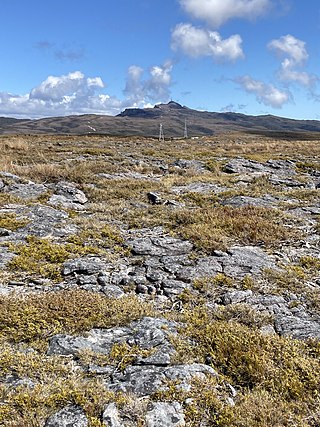
Denniston Plateau is an 18 km long, 600–800 m high coalfield plateau in the Papahaua Range on the West Coast of the South Island of New Zealand. A combination of impermeable rock, high rainfall, and shallow acidic soil has created a unique ecosystem of stunted trees and heath-like vegetation which is home to numerous endemic and undescribed species of plants and invertebrates. The plateau contains rich seams of high-quality coal, which led to the creation and abandonment of the mining towns of Denniston and Millerton, and the current Stockton Mine. Plans to create a new open-cast mine on the southern part of the plateau have become an environmental controversy.
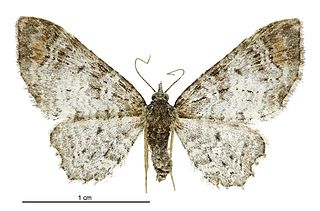
Pasiphila aristias is a species of moth in the family Geometridae. It was described by Edward Meyrick in 1897 and is endemic to New Zealand. This species is found in both the North and South Islands and inhabits subalpine and native forest. Adults are on the wing in December and January and are attracted to light.

Pasiphila bilineolata is a moth in the family Geometridae. It is endemic to New Zealand and can be found in the North and South Islands. The species inhabits native forest and shrubland and the larvae feed on Hebe species. Adults are on the wing commonly from August to January but have been observed most months of the year and are attracted to light.

Arctesthes catapyrrha is a moth of the family Geometridae. It is endemic to New Zealand.

Arctesthes siris is a moth of the family Geometridae. It is endemic to New Zealand and has only been found in a handful of mountainous areas in Central Otago. As at 2019 the larvae of this species has not been described but the larval hosts of this species are low growing plants in the genera Coprosma and Plantago. Adults are day flying and are on the wing from early December until mid April. This species inhabits mountainous wetland areas and snowbanks. It has been observed flying low over its preferred habitat and has been seen together with its sister species A. catapyrrha. A. siris can be distinguished from A. catapyrrha as A. siris has a noticeable concave curve in the proximal line of its forewing.
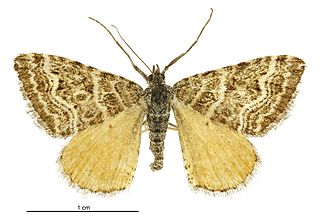
Xanthorhoe bulbulata is a species of moth in the family Geometridae. It is endemic to New Zealand. It is classified as critically endangered by the Department of Conservation.
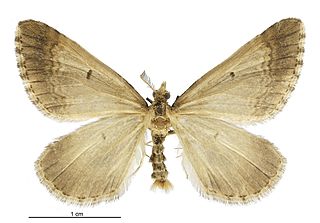
Asaphodes frivola, also known as the remuremu looper moth or Foveaux looper moth, is a species of moth in the family Geometridae with flightless females. It is endemic to New Zealand, and critically endangered, occurring in a very narrow and specialised habitat at just two small coastal sites near Invercargill.

Asaphodes imperfecta is a moth in the family Geometridae. It is endemic to New Zealand and is found in the southern part of the South Island. The species inhabits low lying swampy native forest. The host plants of the larvae of this species is unknown. The adults are on the wing in December and January. It is classified as critically endangered by the Department of Conservation.

Notoreas edwardsi is a species of moth in the family Geometridae. It is endemic to New Zealand. This species has been classified as Nationally Critical by the Department of Conservation.

Notoreas casanova is a species of moth in the family Geometridae. It is endemic to New Zealand. This species has been classified as Nationally Vulnerable by the Department of Conservation.

Helastia clandestina is a moth of the family Geometridae. This species is endemic to New Zealand and is found only in the South Island in and around Arthur's Pass. Adults have been collected on the wing in February and are nocturnal. Its preferred habitat is dry stony riverbeds and flood plains. The glossy blueish grey colouration of the adults of this species helps camouflage them against the rocks in their preferred habitat. H. clandestina is classified as having the conservation status of "At Risk, Relict'" by the Department of Conservation.

Notoreas ischnocyma is a species of moth in the family Geometridae. This species is endemic to New Zealand. This species is found in Canterbury and Otago.
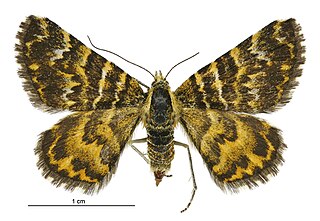
Notoreas elegans is a species of moth in the family Geometridae, endemic to New Zealand. This species has a wide distribution in New Zealand and is therefore regarded as not being in need of conservation.

Notoreas perornata is a species of moth in the family Geometridae. It is endemic to New Zealand and is found in the North Island from Northland to Westland as well as in the South Island on the coast of Marlborough.

Notoreas simplex is a species of moth in the family Geometridae. It is endemic to New Zealand.

Arctesthes avatar, commonly known as the avatar moth or the Denniston triangle moth, is a moth of the family Geometridae and is endemic to New Zealand. It has been found in short-lived wetlands at elevations between 640 and 1000 metres, but only in the areas of the Denniston Plateau and the nearby Mount Rochfort in the Buller District of the West Coast Region of the South Island. The species was discovered by Brian Patrick in 2012, during a bio-blitz on the Denniston Plateau organised by Forest & Bird as part of a campaign against the planned development of an open-cast coal mine by Bathurst Resources. The name of the new species was proposed in 2012, following a competition run by Forest & Bird and judged by Patrick and his son. It was first described by Brian H. Patrick, Hamish J. H. Patrick and Robert J. B. Hoare in 2019. A. avatar has Nationally Critical conservation status under the New Zealand Threat Classification System.
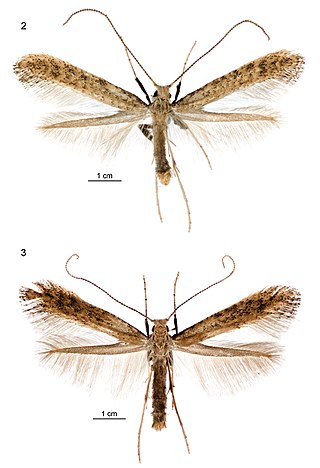
Sabulopteryx botanica is a species of moth in the family Gracillariidae. It is endemic to New Zealand. It was first described in 2019 by Robert Hoare and Brian Patrick. The larval host of this species is Teucrium parvifolium, a plant that has been classified as at risk by the Department of Conservation.

Helastia corcularia is a moth of the family Geometridae. This species is endemic to New Zealand and is found only in the South Island and the Chatham Islands. It inhabits a wide variety of habitats including native forest and scrubland, gardens, parks, subalpine and coastal areas. Larvae feed on herbs, lichen and moss. The adults of the species are on the wing from September until May and are nocturnal and attracted to light. H. corcularia is considered an orchard and pack house contaminant.




















